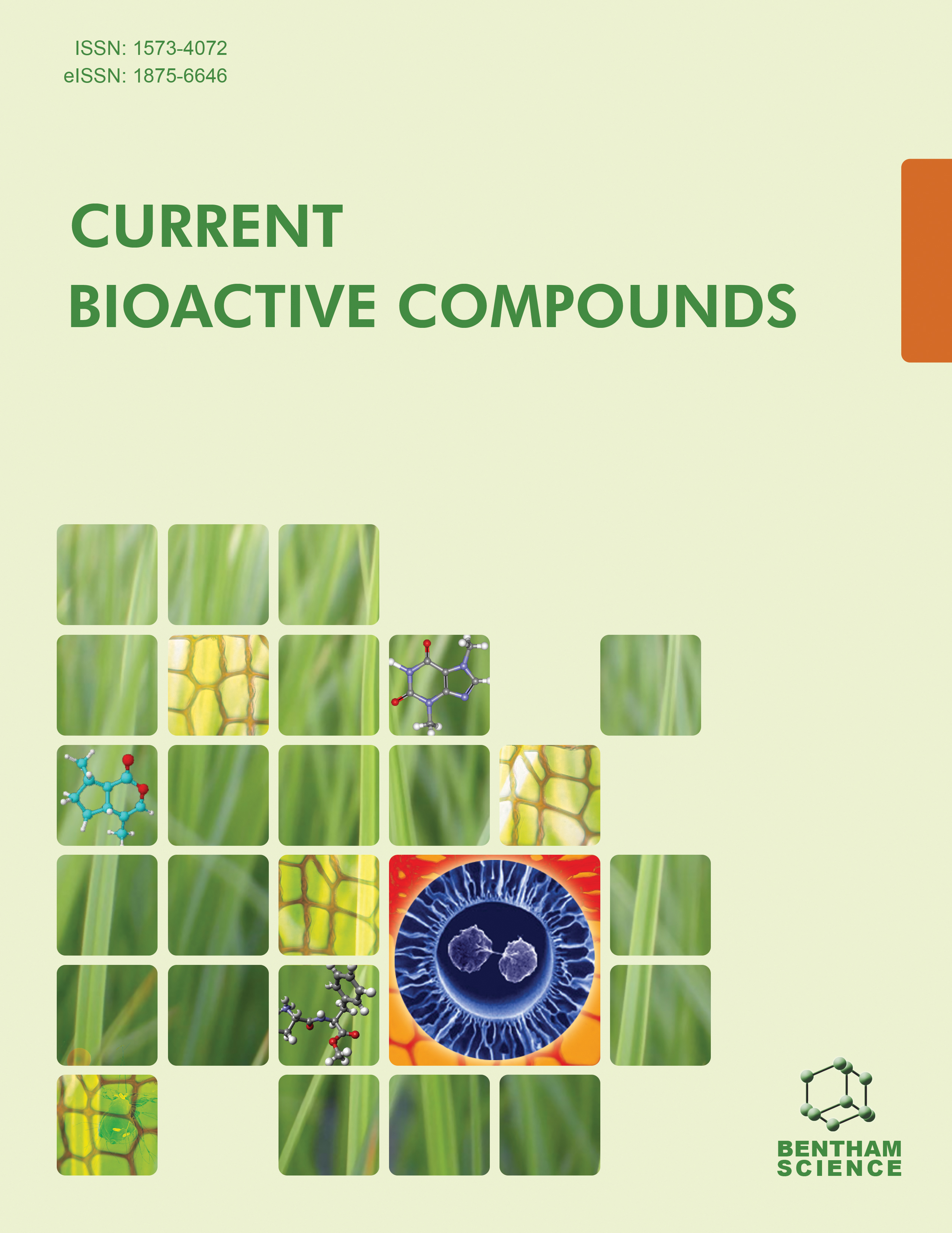- Home
- A-Z Publications
- Current Bioactive Compounds
- Issue Home
Current Bioactive Compounds - Current Issue
Volume 21, Issue 3, 2025
-
-
Recent Review on Herbs and Medicinal Plant-based Nanotechnological Approach in Treating Psoriasis
More LessAuthors: Alka Patel, Parag Jain, Akanksha Thakur and AjazuddinPsoriasis is a long-term inflammatory skin condition that is caused by a typical proliferating keratinocytes that emerge as substantial scaly, red and fragile patches. Although in current therapy, conventional treatments usually involve topical corticosteroids, immunosuppressants, and phototherapy, these therapies have restrictions and undesirable consequences. Nanotechnology provides significant novel opportunities Read More
-
-
-
Synthesis, Characterization, Docking Studies, and In-vitro Cytotoxic Activity of Some Novel N-(Acridin-9-yl)-N-(2- Substituted Benzoyl) Derivatives
More LessAuthors: Madhivadhani Kadiravan and Hemalatha KanagarajanIntroductionA 9-aminoacridine derivative has anticancer properties against several types of cancer cells, including colon, breast, pancreatic, lung, and renal cell carcinoma. It triggers apoptosis by stopping the cell cycle in the S phase and inhibits the activity of topoisomerase. So, the present study deals with the synthesis and anti-cancer activity of some of the acridine derivatives.MethodsThe novel set of N-(acridin-9-yl)-N-(2-s Read More
-
-
-
Pharmacognostic Study and Standardization of Leaves and Stem of Mentha spicata Linn.
More LessAuthors: Neeta Solanki, Sapna Saini, Rajesh Saini, Karnail Singh and Parijat PandeyBackgroundVarious Mentha species are cultivated all over the world due to their aroma and valuable therapeutic constituents. Along with its traditional use as a food flavor, it is well-established folklore medicine for treating digestive and cardiovascular problems. Mentha spicata L. is a perennial, aromatic herb belonging to the Lamiaceae family. M. spicata leaves have been used in traditional systems of medicines for tr Read More
-
-
-
Application of Nanotechnology as a Novel Approach to the Treatment of Skin Cancer
More LessAuthors: Sonia Singh, Aman Gupta and Mahima VarshneySkin cancer has become the fifth most frequently reported form of cancer worldwide, imposing significant economic and public health challenges. Over the course of the last ten years, there has been a significant increase in the application of Nanoparticles (NPs) as a method of therapeutic administration to target skin cancer. The information has been gathered from many online databases, such as Scopus, Pubmed, Science Read More
-
-
-
Anti-carcinogenic Potential of Nano-curcumin -“Killing Cancerous Cells”
More LessNowadays, cancer treatment is currently limited to surgery, chemotherapy, and radiation, which carry the risk of damaging the normal tissue of the body and incomplete removal of the cancerous cells from the body. Thus, the Nano technique offers a great means to target therapies directly on cancerous cells and neoplasm. Moreover, because nano-based formulations of polyphenolic curcumin show a major effect on cancer Read More
-
-
-
Iron(III) Monoglycerolate: A Potential Hemostatic Agent for Topical Application
More LessBackgroundGlycerolates of biogenic elements are of interest because of their pharmacological activity. Some of them are used as active substances in agents for topical application and as biocompatible precursors in sol-gel synthesis of bioactive materials.ObjectiveIn this work, morphostructural feature, ability to hydrolyze, and the pharmacological activity of previously synthesized iron(III) monoglycerolate were Read More
-
-
-
Influence of Parameters of Mechanochemical Processing on the Efficacy of Complex Solid Dispersion of Anthelmintics
More LessBackgroundDue to the fact that animal parasitic diseases often occur in the form of mixed infections, it is necessary to use complex drugs with a combination of active substances that act against different classes of helminths. Fenbendazole has a wide spectrum of nematocidal action and is less effective against cestodes. Considering that sheep are often infected with both gastro-intestinal nematodes and cestodes, a comple Read More
-
Volumes & issues
-
Volume 21 (2025)
-
Volume 20 (2024)
-
Volume 19 (2023)
-
Volume 18 (2022)
-
Volume 17 (2021)
-
Volume 16 (2020)
-
Volume 15 (2019)
-
Volume 14 (2018)
-
Volume 13 (2017)
-
Volume 12 (2016)
-
Volume 11 (2015)
-
Volume 10 (2014)
-
Volume 9 (2013)
-
Volume 8 (2012)
-
Volume 7 (2011)
-
Volume 6 (2010)
-
Volume 5 (2009)
-
Volume 4 (2008)
-
Volume 3 (2007)
-
Volume 2 (2006)
-
Volume 1 (2005)
Most Read This Month Most Read RSS feed
Article
content/journals/cbc
Journal
10
5
false
en

Most Cited Most Cited RSS feed
-
-
Podophyllotoxin: Current Perspectives
Authors: Ying Qian Liu, Liu Yang and Xuan Tian
-
- More Less

